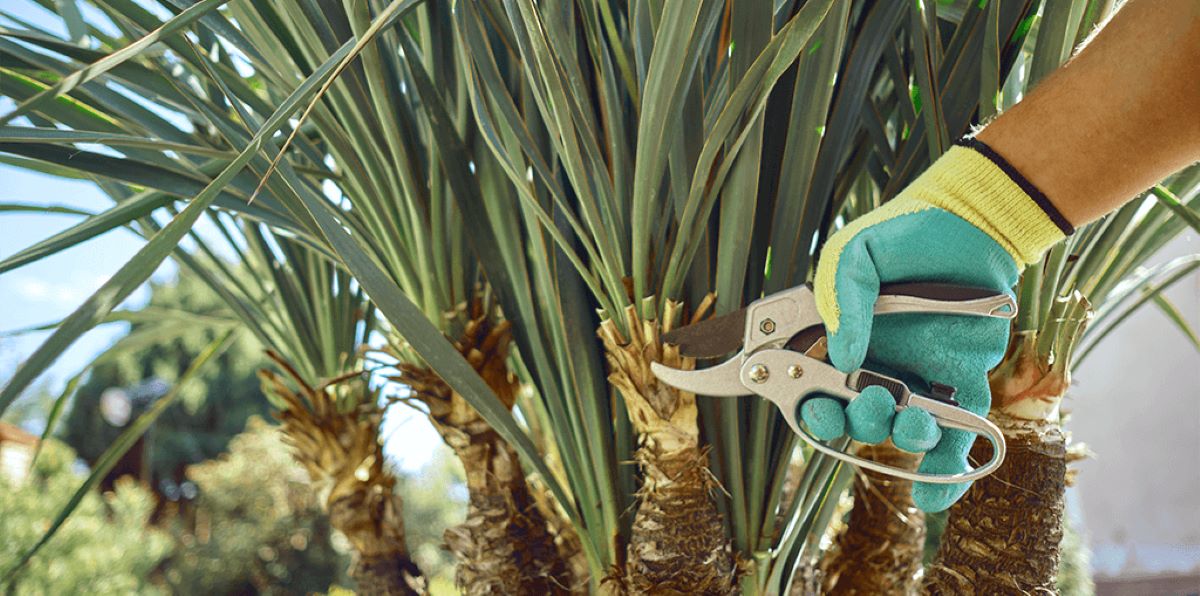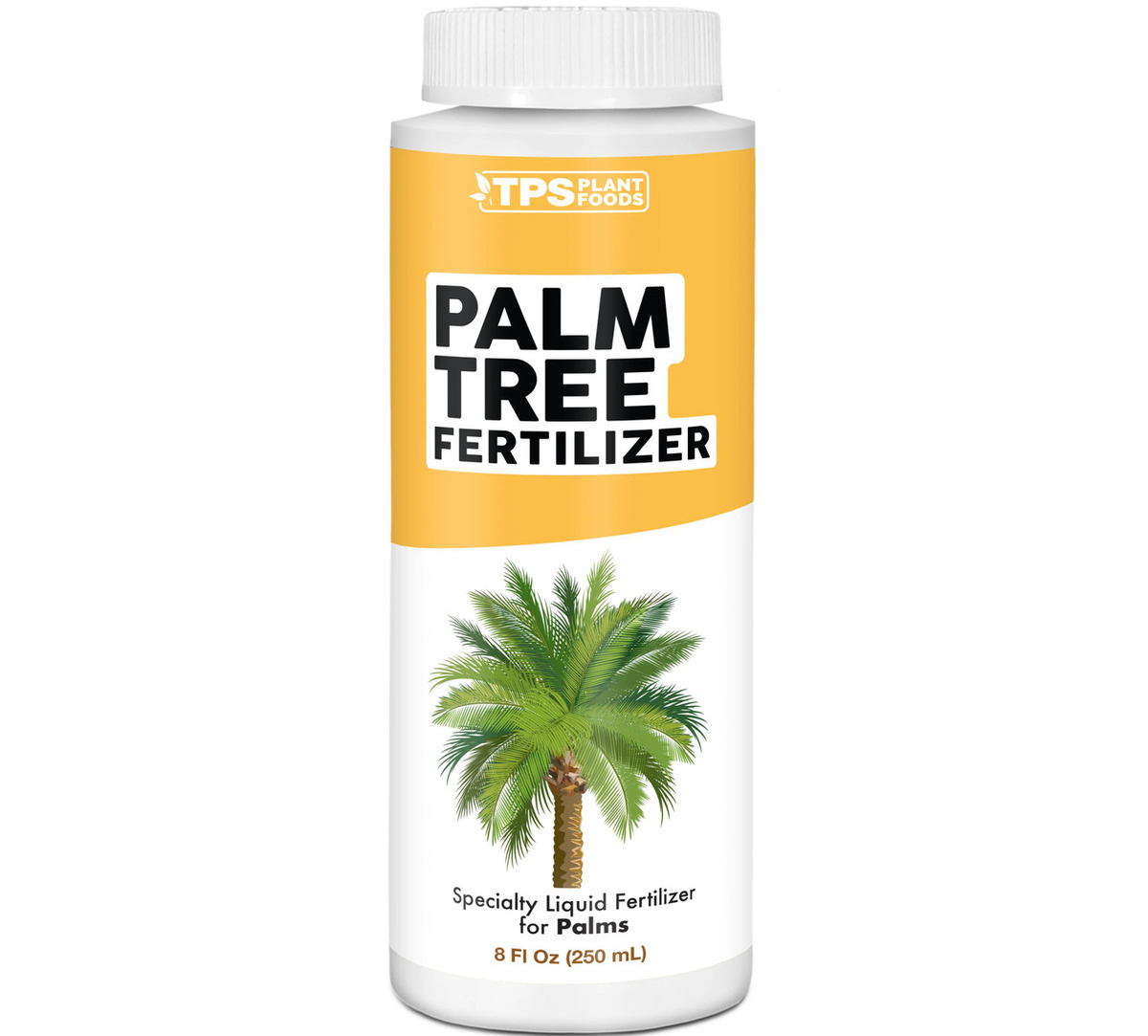Home>Gardening Techniques>Plant Care>How To Fertilize Palm Trees


Plant Care
How To Fertilize Palm Trees
Modified: February 10, 2024
Learn the best plant care techniques for fertilizing palm trees and achieve lush, healthy growth. Enhance the vitality of your palm trees with our expert tips and advice.
(Many of the links in this article redirect to a specific reviewed product. Your purchase of these products through affiliate links helps to generate commission for Chicagolandgardening.com, at no extra cost. Learn more)
Table of Contents
Introduction
Welcome to the world of palm trees, where lush green fronds sway in the gentle breeze and create a tropical paradise in your backyard. As a plant lover, you know that caring for your palm trees is essential to keep them healthy and vibrant. One crucial aspect of palm tree care is fertilization.
Fertilization provides the necessary nutrients for palm trees to thrive and grow vigorously. It helps promote strong root development, lush foliage, and robust growth. However, understanding the proper techniques and timing for fertilizing palm trees is crucial to ensure optimal results.
In this comprehensive guide, we will explore the importance of fertilizing palm trees, the best time to fertilize, the types of fertilizers to use, how to choose the right fertilizer, and the step-by-step process of fertilizing your palm trees. Whether you are a seasoned gardener or a novice plant enthusiast, this article will equip you with the knowledge to enhance the health and beauty of your palm trees.
So, let’s dive deep into the world of palm tree fertilization and unlock the secrets to nurturing these majestic plants.
Why Fertilize Palm Trees?
Palm trees are unique plants that have specific nutritional requirements to thrive in their natural habitat. However, when planted in urban or suburban environments, they may not have access to the same nutrient-rich soil they would have in their native tropical regions. Fertilizing palm trees helps bridge this gap and provides the essential nutrients they need to maintain optimal health.
Here are three key reasons why fertilizing palm trees is crucial:
- Promotes Growth and Development: Palm trees require a range of essential nutrients, including nitrogen, phosphorus, and potassium, to support their growth and development. These nutrients are vital for the formation of new fronds, stronger roots, and overall healthy plant structure. Fertilizing palm trees ensures they receive these nutrients in adequate amounts, promoting robust growth and vibrant foliage.
- Improves Resistance to Diseases and Pests: Well-fed palm trees are better equipped to resist diseases and pests that can wreak havoc on their health. When palm trees lack the necessary nutrients, they become more susceptible to infections, infestations, and overall decline. Fertilizing them strengthens their immune system and enhances their natural defenses, making them less vulnerable to common palm tree ailments.
- Enhances Aesthetic Appeal: Palm trees are renowned for their graceful beauty and ornamental value. By providing them with the right nutrients, you can enhance their overall appearance. Fertilizers containing micronutrients like iron and manganese can help prevent the development of yellow or chlorotic leaves, ensuring your palm trees retain their lush green color and stunning visual appeal.
Overall, fertilizing palm trees is essential for their overall well-being, growth, and ability to withstand environmental stressors. It not only helps them thrive but also ensures they remain resilient and stunning additions to your landscape. In the next section, we will explore the optimal timing for fertilizing palm trees.
When to Fertilize Palm Trees
Timing is crucial when it comes to fertilizing palm trees. Applying fertilizer at the right time ensures that the nutrients are available when the palm trees need them the most. The timing will depend on several factors, including the species of palm tree, geographical location, and local climate conditions.
Here are some general guidelines to determine the best time to fertilize your palm trees:
- Spring: Spring is generally the ideal time to start fertilizing palm trees. As temperatures begin to rise and the days become longer, palm trees enter their active growing phase. Fertilizing in early spring helps provide the necessary nutrients to support new growth and development.
- Summer: During the summer months, palm trees are typically in full swing, with an abundance of foliage and increased energy requirements. Applying a slow-release fertilizer in late spring or early summer can help sustain their growth and vitality throughout the season.
- Fall: In fall, palm trees naturally slow down their growth as cooler temperatures and shorter days prevail. Fertilizing in early fall can help prepare them for the upcoming winter months and provide the necessary nutrients to build up their reserves.
- Winter: In colder regions, fertilization is typically not recommended during winter when palm trees are dormant. However, if you live in a warmer climate where palm trees continue to grow during the winter months, a light application of fertilizer in late fall or early winter can suffice.
It’s important to note that while these are general guidelines, the specific timing may vary depending on your location and the unique needs of your palm tree species. Additionally, it’s important to observe the condition of your palm trees and adjust the fertilization schedule accordingly. For instance, if you notice signs of nutrient deficiencies or slow growth, you may need to increase the frequency of fertilization.
Keep in mind that over-fertilizing palm trees can be detrimental and lead to nutrient imbalances or burn the roots. Therefore, it’s crucial to follow the recommended fertilizer application rates and avoid excessive use.
In the next section, we will explore the different types of fertilizers available for palm trees.
Types of Fertilizers for Palm Trees
When it comes to fertilizing palm trees, there is a wide range of options available in the market. Understanding the different types of fertilizers and their specific formulations will help you make an informed decision about which one is most suitable for your palm trees.
Here are some common types of fertilizers for palm trees:
- Complete Granular Fertilizers: These fertilizers contain a balanced ratio of nitrogen (N), phosphorus (P), and potassium (K), often referred to as NPK. They provide a comprehensive supply of essential nutrients required for palm tree growth and development. Complete granular fertilizers are easy to use and are available in different formulas, such as 18-6-12 or 12-4-12.
- Specialized Palm Fertilizers: Palm-specific fertilizers are designed to meet the unique nutritional requirements of palm trees. They often contain additional micronutrients like iron (Fe), manganese (Mn), and magnesium (Mg) that are crucial for healthy palm growth. These specialized formulations can help address specific deficiencies common in palm trees.
- Slow-Release Fertilizers: Slow-release fertilizers are formulated to gradually release nutrients over an extended period, providing a steady supply of nutrients to palm trees. They help prevent nutrient leaching and minimize the risk of over-fertilization. Slow-release fertilizers are available in granular form and are ideal for palm trees that require less frequent fertilization.
- Organic Fertilizers: Organic fertilizers are derived from natural sources, such as compost, manure, or plant-based materials. They provide a slow and steady release of nutrients and help improve soil health over time. Organic fertilizers are an eco-friendly option and are suitable for gardeners who prefer a more sustainable approach to palm tree care.
When choosing a fertilizer for your palm trees, consider factors such as the age and size of the palm trees, the specific nutrient requirements, and any specific deficiencies or soil conditions that need to be addressed. It’s also important to follow the manufacturer’s instructions for application rates and frequency.
In the next section, we will discuss how to choose the right fertilizer for your palm trees.
How to Choose the Right Fertilizer
Choosing the right fertilizer for your palm trees is crucial to ensure they receive the appropriate balance of nutrients for optimal growth and health. Here are some factors to consider when selecting a fertilizer:
- NPK Ratio: Look for a fertilizer with a balanced NPK ratio. Palm trees typically require a ratio of nitrogen (N), phosphorus (P), and potassium (K) such as 12-4-12 or 18-6-12. This balanced ratio ensures that your palm trees receive the necessary macronutrients to support their growth and development.
- Micronutrients: Palm trees also need various micronutrients like iron (Fe), manganese (Mn), and magnesium (Mg) for optimal health. Check if the fertilizer you choose contains these essential micronutrients, especially if your palm trees show signs of deficiency or are growing in nutrient-poor soils.
- Solubility: Consider the solubility of the fertilizer. Granular fertilizers release nutrients slowly over time, while soluble fertilizers dissolve quickly and provide a more immediate nutrient boost. Choose the appropriate solubility based on the specific needs of your palm trees.
- Application Method: Determine how you plan to apply the fertilizer. Granular fertilizers are typically spread on the soil surface and watered in, while liquid fertilizers can be applied directly to the base of the palm tree or diluted and sprayed on the foliage. Choose a fertilizer and application method that aligns with your preference and ease of use.
- Sustainability: Consider using organic or slow-release fertilizers for a more sustainable approach to palm tree care. These options not only provide nutrients to the palm trees but also improve soil health and minimize environmental impact.
- Brand Reputation: Research and choose reputable brands known for their quality fertilizers. Read reviews, seek recommendations from experienced gardeners, and look for third-party certifications to ensure that you are purchasing a reliable and effective product.
Always follow the manufacturer’s instructions for the application rates and frequency. Over-fertilization can harm palm trees and lead to nutrient imbalances, while under-fertilization may result in nutrient deficiencies and stunted growth.
By considering these factors and making an informed decision, you can choose the right fertilizer that meets the specific needs of your palm trees and promotes their overall health and vitality.
In the next section, we will discuss the necessary preparations before fertilizing your palm trees.
Preparing to Fertilize Palm Trees
Before you begin the actual process of fertilizing your palm trees, it’s important to properly prepare for the task. Taking the time to prepare will ensure that the fertilization process is efficient, effective, and safe for your palm trees. Here are some steps to follow when preparing to fertilize your palm trees:
- Choose the Right Time: Refer to the recommended fertilization timing for palm trees in your region. Determine the appropriate season or month to fertilize based on the growth and nutrient requirements of your palm trees.
- Inspect the Palm Trees: Before fertilizing, examine your palm trees for any signs of nutrient deficiencies, pests, or diseases. Look for yellowing leaves, stunted growth, or any other visible issues. Address these problems before proceeding with fertilization.
- Test the Soil: Conduct a soil test to assess the nutrient levels and pH of the soil. This will help you determine if any amendments or specific fertilizers are needed to correct deficiencies or imbalances. Soil testing kits are available at garden centers or consider sending a soil sample to a professional laboratory for more accurate results.
- Choose the Fertilizer: Based on the results of the soil test and the specific needs of your palm trees, select the appropriate fertilizer. Consider the NPK ratio, micronutrient content, and the application method (granular or liquid) that best suits your palm trees.
- Gather the Tools and Equipment: Collect all the necessary tools and equipment you’ll need for the fertilization process. This may include a fertilizer spreader for granular fertilizers or a spray bottle or applicator for liquid fertilizers.
- Read and Follow Instructions: Carefully read the instructions provided by the fertilizer manufacturer. Pay attention to the recommended application rates, frequency, and any additional guidance or precautions mentioned.
- Protective Gear: Wear appropriate protective gear, such as gloves, goggles, and a mask, especially if you are using granular fertilizers or handling concentrated liquid fertilizers. This will help protect your skin, eyes, and respiratory system from any potential irritation or allergic reactions.
By taking these preparatory steps, you’ll ensure that you are well-equipped and ready to fertilize your palm trees effectively and safely. Now that you are prepared, let’s move on to the step-by-step process of fertilizing palm trees.
Steps to Fertilize Palm Trees
Now that you have prepared for the fertilization process, it’s time to follow these step-by-step instructions to properly fertilize your palm trees:
- Measure the Area: Begin by measuring the area around the palm tree where you will be applying the fertilizer. This will help you determine the correct amount of fertilizer to use.
- Calculate the Fertilizer Amount: Refer to the instructions provided by the fertilizer manufacturer to determine the appropriate amount of fertilizer to apply based on the size and age of your palm tree. Measure out the recommended quantity.
- Spread Granular Fertilizer: If you are using granular fertilizer, evenly spread the measured quantity around the base of the palm tree, extending it to the drip line, which is the outermost edge of the canopy. Avoid placing the fertilizer directly against the trunk to prevent potential damage.
- Water in the Fertilizer: After applying the fertilizer, thoroughly water the area to help the nutrients reach the root zone. Watering will also prevent the fertilizer from sitting on the surface and potentially causing burn to the palm tree roots.
- Apply Liquid Fertilizer: If you are using liquid fertilizer, dilute it according to the instructions provided. Apply the diluted fertilizer directly to the base of the palm tree, ensuring that it reaches the root zone. Alternatively, you can spray the foliage if the fertilizer is specifically formulated for foliar application.
- Water Again: After applying the liquid fertilizer, give the palm tree a thorough watering to help the nutrients penetrate the soil and reach the roots. This will aid in the absorption and utilization of the fertilizers by the palm tree.
- Maintain a Fertilization Schedule: To ensure ongoing health and growth of your palm trees, establish a regular fertilization schedule. Follow the recommended timing and frequency specified by the fertilizer manufacturer or based on the specific needs of your palm tree species.
- Monitor and Adjust: Keep a close eye on your palm trees after fertilization. Monitor their growth, foliage color, and overall health. If you notice any signs of over-fertilization or nutrient deficiencies, make the necessary adjustments to your fertilization routine.
Remember, the goal is to provide the proper amount of nutrients to your palm trees without causing harm or imbalance. By following these steps and maintaining a consistent fertilization schedule, you’ll be supporting the health, growth, and beauty of your palm trees for years to come.
Now that you know how to fertilize your palm trees, let’s explore some tips to further enhance your fertilization practices in the next section.
Tips for Fertilizing Palm Trees
Fertilizing palm trees is not only about following the basic steps but also implementing some additional tips and best practices to ensure optimal results. Here are some helpful tips to enhance your palm tree fertilization process:
- Follow the Fertilizer Schedule: Stick to the recommended fertilization schedule for your specific palm tree species. Consistency is key when providing the necessary nutrients throughout the year.
- Water Before and After Fertilization: For granular fertilizers, water the area around the palm tree before applying the fertilizer. This will help prevent potential root burn. After fertilization, water the area again to ensure nutrients are absorbed and avoid any fertilizer remaining on the surface.
- Avoid Fertilizing Newly Planted Palm Trees: Newly planted palm trees need time to establish their root systems before being fertilized. Wait at least three to six months after planting before starting a fertilization routine.
- Use Slow-Release Fertilizers for Convenience: Consider using slow-release fertilizers to simplify the fertilization process. These types of fertilizers release nutrients gradually over time, reducing the frequency of applications.
- Avoid Using Excessive Fertilizers: Over-fertilizing can be harmful to palm trees. Always follow the recommended application rates and avoid the temptation to apply more fertilizer than necessary.
- Apply Fertilizer Beyond the Drip Line: Extend the fertilizer application beyond the canopy’s outermost edge, known as the drip line. This ensures that the entire root system of the palm tree has access to the nutrients.
- Protect the Trunk While Applying Granular Fertilizer: To prevent potential trunk damage, create a buffer zone around the trunk when applying granular fertilizer. Spread the fertilizer around the base of the palm tree, ensuring it does not come into direct contact with the trunk.
- Consider Palm-Specific Fertilizers for Specialized Nutrient Needs: Palm-specific fertilizers often contain additional micronutrients that cater specifically to the needs of palm trees. These specialized formulations can help address common deficiencies and promote optimal growth.
- Maintain Good Soil Drainage: Palm trees thrive in well-draining soil. Ensure proper drainage around your palm trees to avoid waterlogged conditions, as excessive moisture can hinder nutrient absorption and lead to root rot.
- Regularly Inspect Palm Trees: Regularly inspect your palm trees for signs of nutrient deficiencies, pest infestations, or diseases. Promptly addressing any issues will help maintain their overall health and minimize the need for corrective measures.
By implementing these tips, you can refine your palm tree fertilization practices and ensure that your palm trees receive the right nutrients at the right time, resulting in healthier and more beautiful trees.
In the next section, we will explore some common mistakes to avoid when fertilizing palm trees.
Common Mistakes to Avoid
While fertilizing palm trees is essential for their health and vitality, there are some common mistakes that can negatively impact their well-being. By being aware of these mistakes, you can avoid them and ensure that your palm trees receive the best care possible. Here are some common mistakes to avoid when fertilizing palm trees:
- Over-Fertilization: Applying too much fertilizer can lead to nutrient imbalances, root burn, and overall stress on the palm trees. Follow the recommended application rates and frequency provided by the fertilizer manufacturer.
- Under-Fertilization: On the other hand, inadequate fertilization can result in nutrient deficiencies, stunted growth, and a weakened immune system in palm trees. Ensure you provide an appropriate amount of nutrients based on the specific needs of your palm tree species.
- Fertilizing Newly Planted Palm Trees: Newly planted palm trees need time to establish their root systems before being fertilized. Avoid fertilizing them for at least three to six months after planting to allow proper root development.
- Incorrect Timing: Fertilizing palm trees at the wrong time can be detrimental to their growth. Follow the recommended fertilization timing for your specific palm tree species and climate conditions.
- Applying Fertilizer Against the Trunk: Direct contact between fertilizer and the trunk can damage the palm tree. Always create a buffer zone around the trunk when applying granular fertilizer to prevent potential trunk burn.
- Using Unsuitable Fertilizers: Not all fertilizers are suitable for palm trees. Avoid using fertilizers with high levels of nitrogen (N) or those designed for other types of plants. Choose a fertilizer specifically formulated for palm trees to meet their unique nutritional requirements.
- Ignoring Soil Testing: Neglecting to conduct soil tests can result in either unnecessary or inadequate fertilization. Soil testing helps determine any nutrient deficiencies or imbalances, allowing you to apply the correct fertilizer and amendments.
- Improper Watering: Water plays a crucial role in the absorption of nutrients. Improper watering practices, such as overwatering or underwatering, can impact nutrient uptake and lead to poor fertilization results. Ensure proper and consistent watering before and after fertilization.
- Neglecting Other Cultural Practices: Fertilization should be combined with other essential cultural practices like proper pruning, regular pest management, and maintaining good soil health. Neglecting these practices may hinder the effectiveness of fertilization.
- Ignoring Signs of Problems: Regularly inspect your palm trees for signs of nutrient deficiencies, pests, or diseases. Ignoring these signs can worsen the condition of the palm trees and require more intensive measures to rectify the issues.
By avoiding these common mistakes, you can ensure that your palm trees receive the right amount of nutrients, at the right time, and in the right way, helping them thrive and flourish in your landscape.
In the final section, we will wrap up this comprehensive guide on fertilizing palm trees.
Conclusion
Fertilizing palm trees is a crucial aspect of their care and maintenance, ensuring they receive the necessary nutrients for optimal growth, vibrant foliage, and resistance to diseases. By understanding the importance of fertilization and following the right practices, you can enhance the health and beauty of your palm trees.
In this comprehensive guide, we have explored why fertilizing palm trees is essential, the best timing for fertilization, different types of fertilizers available, tips for choosing the right fertilizer, and the step-by-step process of fertilizing palm trees. We have also discussed common mistakes to avoid to ensure successful fertilization.
Remember, each palm tree species may have specific nutrient requirements and unique environmental conditions, so it is crucial to research and understand the specific needs of your palm trees. Regular inspection and attentive care will help you monitor their health and make any necessary adjustments to your fertilization routine.
With proper fertilization, your palm trees will thrive, adding elegance and beauty to your landscape. So, go ahead and start incorporating these fertilization techniques into your palm tree care routine. Your palm trees will thank you with their lush, vibrant foliage and resilient health.










